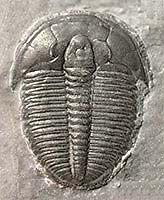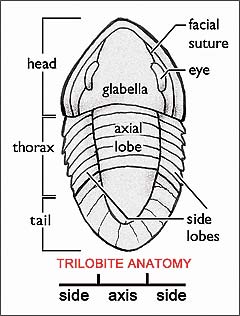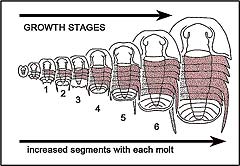 |
| Probably Utah’s most common trilobite, Elrathia kingi, is typically only about an inch long. |
Last year Moab Happenings published a series of articles on the activities of our Dinosaur Trackers Research Group, which includes various Moab residents and friends and colleagues from Colorado. As trackers we followed the tracks and trails, called trace fossils, of once living, breathing animals. But all these animals would eventually die. Only if their remains survived the decay process might we find what paleontologists call body fossils: the actual remains of skeletons, or shells, in the case of invertebrates like clams or snails. Professional paleontologists distinguish between trace and body fossils: i.e., between life activity and death. Many paleontologists study only one category for an entire career. But for a complete picture we must study evidence from both fields. So, this series of articles shifts focus to body fossils, the actual remains of once living animals, especially examples from the Moab area.
But first some general guidelines. Body fossils range in size from the complete skeletons of minute plankton and medium sized clams, snails and ammonites (many from marine deposits), to the skeletons of small, medium and large vertebrates as diverse as frogs, turtles, crocodiles, dinosaurs, birds and mammals. Plant fossils, like logs and leaves, count also. Some of these body fossils, like snails and ammonites are usually found complete, as are the shells of turtles, but many are found incomplete: so while a few dinosaur bones may indicate a new species they are not the complete animal. A 90% complete skeleton is a rare find with all knee bones connected to the thigh bones: what paleontologists call “articulated.” A dinosaur mummy, with the skeleton is still encased in dried-out skin is even rarer. When big animals die, if not buried quickly (the best ways to become of
 |
| Trilobite Anatomy: the trilobite is so named because it has three lobes: one on each side, and one along the central axis. Its head, thorax and tail also divides its body three ways from anterior to posterior. |
fossil, in case you’re planning ahead) they get torn apart by scavengers, and damaged by erosion and weathering. The study of death and decay is called “taphonomy” – a bit like what forensic anthropologists do in CSI dramas.
Let us again travel through time from the Paleozoic Era of “old life” to the Mesozoic and Cenozoic Eras of “middle and recent life.” We can dip our toes into ancient oceans where millions of shells accumulated into reefs and limestones, and see how later, on land or in freshwater rivers and lakes, larger animals became fossilized leaving complete or partial bodily remains for us to study. We should begin early in the Paleozoic, in the Cambrian Period, when the TRILOBITE was a dominant form. Utah is one of the world’s trilobite capitals. Around Delta in western Utah literally millions of Cambrian trilobites have been dug up, and professionally classified into hundreds of distinct species. The trilobite, an arthropod with a distinctive head, thorax and tail, resembles a marine rolly-polly, and some species did indeed roll up tightly for protection against predators. John Foster, former director of the Museum of Moab, and distinguished member of our tracker team, gives one of the best accounts of trilobite life in his excellent book Cambrian Ocean World, when animal life was just getting started. Like today’s crabs, lobsters and other arthropods (indicating jointed legs and bodies), trilobites shed their external exoskeletons as they grew, about 11% with each molt. With each “make over” molt they reincarnated with more elaborate anatomy and body segments. The trilobites went extinct at the end of the Paleozoic era, but they are still among the best known of all body fossils and prized for their symmetry and intricate beauty. No paleontology collection is complete without at least one – best from Utah of course!
 |
| Trilobite Growth: trilobites molted like other arthropods. Growing about 11% with each molt their anatomy became more elaborate as they matured. |
|